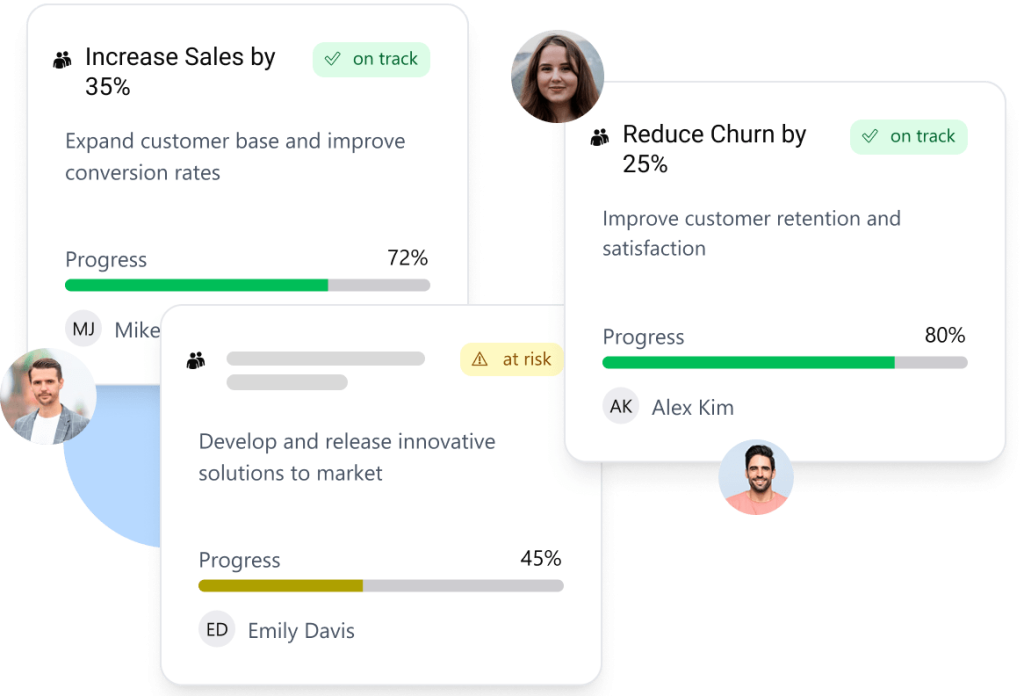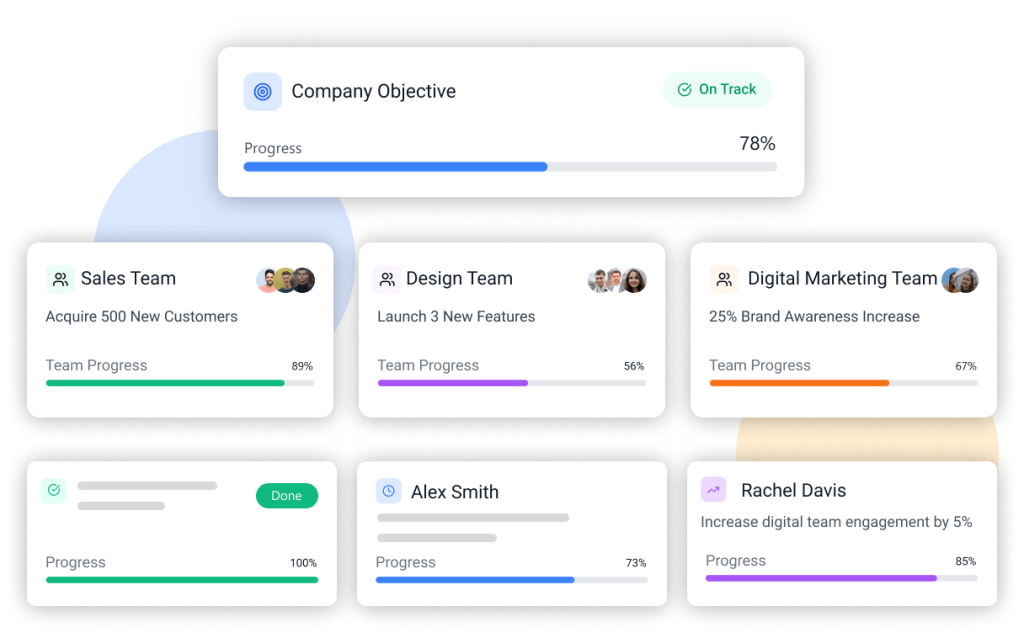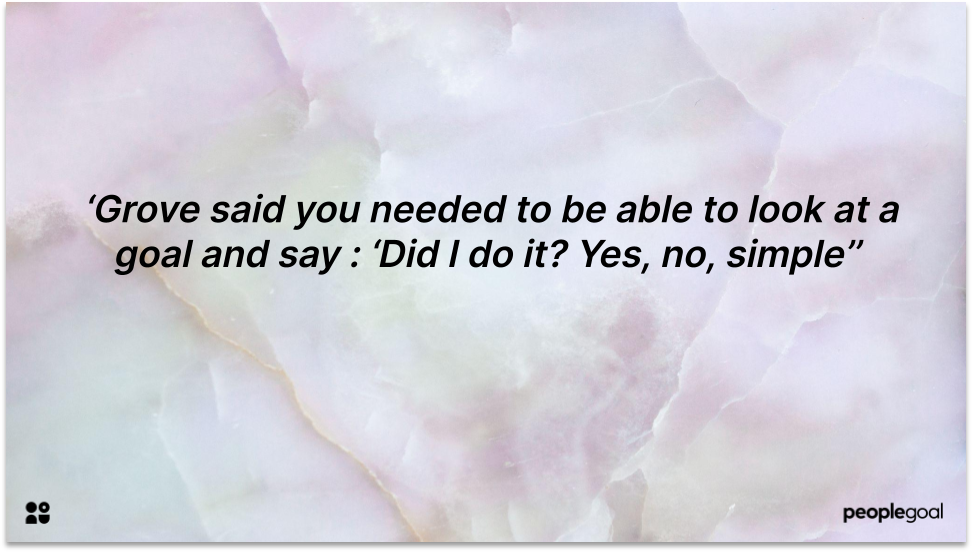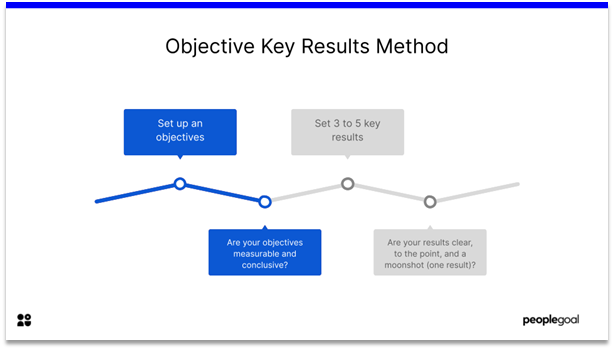Hi there,
Let’s get straight to the point. This blog is your one-stop guide for objectives and key results (OKRs), and in this, I will help you understand the following:
- What are OKRs, and how to write OKRs that are ambitious yet practical
- How to implement them through the quarterly OKR cycle
- How to avoid mistakes that derail company goals
With this, you’ll have a proven system to boost alignment, sharpen accountability, and drive measurable business growth.
Sounds good? Let’s start with a basic question:
What Are OKRs?
“OKR” stands for Objectives and Key Results. It is a goal-setting framework designed to help individuals, teams, and organizations define ambitious goals and track measurable progress. At its core, OKRs combine vision with execution: the Objective is what you want to achieve, and the Key Results are the outcomes that prove you are getting there.
Objectives
An Objective describes what you want to accomplish. It should be inspiring, ambitious, and clear enough to guide action. Strong Objectives often take the form of stretch goals: targets that push a team beyond business as usual. For example, “Improve customer trust” could be a company-level Objective. It’s not a task list, but rather a bold direction that motivates people.
Key Results
Key Results define how success will be measured. They are quantitative, specific, and time-bound. A good Key Result is always tied to a number, because numbers make progress verifiable. If the Objective is “Improve customer trust,” sample Key Results might be:
- Raise the Net Promoter Score (NPS) from 45 to 60 this quarter
- Reduce customer complaints by 25%
- Achieve a 90% satisfaction score in post-support surveys
These are outcome-oriented goals, not tasks. At the end of a quarterly goal cycle, you can grade each Key Result as achieved, partially achieved, or not achieved.

Why OKRs Work
The strength of OKRs lies in their clarity and adaptability. By setting ambitious goals and pairing them with measurable results, teams build focus, alignment, and accountability. Unlike vague company goals, OKRs provide visibility across departments, creating strong team alignment and making sure everyone rows in the same direction.
This is why many organizations adopt the OKR methodology, which turns strategy into structured, measurable outcomes that drive real progress.
This transparency also supports performance management in a modern way. Instead of one-off annual reviews, OKRs encourage continuous performance management, where progress is tracked, discussed, and refined regularly. Organizations find that this rhythm improves engagement and helps employees connect everyday work to strategy.
Now that we understand what OKRs are and why they matter, let’s move one step further. Let’s see how to actually write OKRs that work in practice.
How to Write Effective OKRs
When I first started working with Objectives and Key Results, the hardest part was keeping them simple. Writing OKRs is not about filling a template with nice words; it’s about creating a structure that pushes your team forward. The good news is that there’s a clear formula you can follow.
The OKR Formula
The basic rule is straightforward:
I will [Objective] as measured by [Key Results].”
This format makes it easy to turn company goals into specific, outcome-oriented goals that can be tracked quarter by quarter.
Writing Good Objectives
A strong Objective should be:
- Inspiring and qualitative: It should capture ambition in plain language.
- Concise and memorable: People should be able to recall it without looking it up.
- Limited in number: Stick to 3–5 Objectives per team or quarter, otherwise focus is lost.
- Stretching but realistic: Objectives should feel like ambitious goals, not just business as usual.
Example: Instead of “Continue posting on social media,” you could write, “Build a strong online presence in our industry.”
Writing Good Key Results
Key Results are where the numbers come in. They transform inspiration into measurable progress. A good Key Result should be:
- Specific and measurable: Always tied to a number or target.
- Outcome-based: Focused on results, not tasks.
- Time-bound: Usually tied to quarterly goals.
Example: Instead of saying, “Analyze customer satisfaction,” I would write: “Publish customer satisfaction levels by March 7th with at least 1,000 responses.”
It also helps to mix leading indicators (like website engagement or demo requests) with lagging indicators (like revenue or retention). This balance ensures you’re measuring both effort and impact.
One mistake I made early on was thinking OKRs should only flow from leadership. In reality, OKR examples show us they work best when teams co-create them.
Leaders can set direction, but employees often have the best sense of what’s achievable. That’s why I encourage a bottom-up process supported by OKR templates and workshops. When teams contribute directly, you get stronger team alignment and higher commitment.
Why This Step Matters
Learning how to set and track OKRs properly is the foundation for every other stage. If you rush through this step, you’ll end up with vague goals or a list of tasks instead of measurable outcomes.
Taking the time to write inspiring objectives and verifiable key results ensures your OKRs will actually guide performance and not just decorate a planning document.
Now that we know how to write OKRs, the next question is simple: how do we put them into action?
Let’s walk through the OKR cycle and see the best practices for implementation.
Implementing OKRs: The OKR Cycle and Best Practices
When I first rolled out OKRs with my team, I quickly realized that writing them was only half the battle. The real challenge is in OKR implementation, which means making sure they are tracked, reviewed, and refined on a regular rhythm.
That’s where the OKR cycle comes in.
The OKR Cycle
Most organizations run OKRs on a quarterly goal basis. The cycle usually looks like this:
- Draft objectives and key results.
- Align them across teams and departments.
- Run weekly or bi-weekly check-ins to update progress.
- Grade and review results at the end of the quarter.
This repeatable cycle keeps the OKR process lightweight but powerful. It prevents them from becoming another dusty planning document that nobody revisits.
The Role of OKR Software
Early on, I made the mistake of tracking OKRs in spreadsheets. It works for a few people, but once you scale, it gets messy fast. Dedicated OKR software tools like PeopleGoal make the process far smoother. They improve transparency, give everyone access to the same data, and connect goals to real-time metrics.
Here’s a quick video on how to write and set up OKRs using dedicated software:
With the right OKR software, you avoid endless manual updates and instead focus on driving results.
Grading OKRs
At the end of a cycle, OKRs are graded, often on a 0 to 1.0 scale. For example:
- 1.0 = fully achieved
- 0.7 = mostly achieved
- 0.3 = partially achieved
The sweet spot is around 0.6 to 0.7. This means the goals were ambitious but not impossible. If you consistently hit 100%, chances are you’re not setting true stretch goals.
This is also where many confuse OKRs with Key Performance Indicators (KPIs). KPIs measure ongoing business health, such as uptime, churn, or revenue margins. OKRs, by contrast, are meant to drive significant change.
A struggling KPI can become the basis for a Key Result, but the two are not interchangeable.
OKR Best Practices for Success
From my experience, these principles make all the difference:
- Keep check-ins short and focused on progress.
- Celebrate outcomes, not just activity.
- Make results visible to everyone for accountability and team alignment.
- Use OKRs as part of continuous performance management, not a once-a-year review.
When OKRs are integrated into the rhythm of work, they stop being an “OKR management exercise” and start becoming a growth engine for the company.
We’ve seen how to implement OKRs, but writing them down and checking them off isn’t enough. The truth is, many companies stumble.
Let’s look at the most common mistakes I’ve seen and how you can avoid them.
Common OKR Mistakes & How to Avoid Them
When I started managing objectives and key results, I made almost every mistake in the book.
Over time, I learned that most OKR struggles fall into a handful of categories. Recognizing these early can save you a lot of wasted effort.
Mistake 1: Confusing OKRs with KPIs
This is probably the most common trap. KPIs track the ongoing health of the business, like revenue growth or server uptime. OKRs, on the other hand, are for driving significant change.
The difference between KPIs and OKRs must always be clear. If your sales KPI is underperforming, you might set an OKR to improve that metric, but the two serve different purposes.
Mistake 2: Business-as-Usual OKRs
Some teams simply rewrite their regular tasks as OKRs. That kills the spirit of the OKR framework. Well, these should set ambitious goals and push toward progress, not just maintain the status quo. If you’re already doing it, it’s not an OKR, it’s just work.
Mistake 3: Setting Too Many OKRs
I once helped a client who had 25 OKRs on a single dashboard. Nobody knew what mattered most. As a result, there was no focus, no results.
OKRs only work when they narrow attention to a few outcome-oriented goals. Stick to three to five per team, per quarter.
Mistake 4: “Set It and Forget It” Syndrome
Another classic failure is writing OKRs once and never revisiting them. This is where the phrase why OKRs fail often comes up. OKRs need regular check-ins, grading, and reflection. Without it, they’re just words in a document.
Mistake 5: Treating Key Results as Tasks
A Key Result is not “launch a new campaign” or “host a webinar.” Those are activities. A proper Key Result is measurable, like “gain 2,000 qualified leads” or “achieve 15% conversion from the webinar.”
OKRs are about results, not to-do lists.
Mistake 6: Lack of Vision or Strategy
Finally, OKRs collapse if the company doesn’t have a clear vision. They are a tool for strategy execution, not a substitute for strategy itself. A vague vision leads to vague OKRs, and vague OKRs don’t motivate anyone.
Quick Fixes
- Use OKRs for transformation, not maintenance.
- Connect OKRs to a clear vision and company goals.
- Keep them focused and measurable.
- Regularly review progress to keep momentum alive.
- Involve teams in the process to strengthen alignment and buy-in.
Avoiding these mistakes means your OKRs will actually drive change instead of becoming a buzzword exercise.
Now that we have learned from our mistakes, let’s dive into detailed OKR examples across departments and see how different teams can use them to turn strategy into measurable results.
Objectives and Key Results in Practice: Examples Across Departments

When guiding teams through OKR workshops, I always bring out sample OKR templates. They help people visualize what a strong objective and its key results should look like. Below are detailed OKR examples that you can adapt to your own company goals.
These are structured as quarterly goals, but the same logic applies to annual or project-based OKRs.
Company-Level OKRs
Objective: Strengthen overall company growth and trust with customers.
Key Results:
- Increase Net Promoter Score (NPS) from 45 to 60.
- Reduce churn rate from 8% to 5% within this quarter.
- Achieve 20% growth in new customer signups.
Why it works: These outcome-oriented goals are measurable, ambitious, and aligned with strategy execution. They ensure leadership sets the tone for the entire business.
Marketing OKRs
Objective: Boost brand awareness and lead generation in North America.
Key Results:
- Grow website traffic to 100,000 visits this quarter.
- Secure 2,000 media mentions and backlinks.
- Achieve a 20% increase in marketing-qualified leads (MQLs).
This is one of the most common OKR examples for marketing. Notice that the Objective is qualitative (“boost brand awareness”), while the Key Results are precise, measurable outcomes.

Sales OKRs
Objective: Expand enterprise sales pipeline and improve conversion rates.
Key Results:
- Book 50 qualified demos with target accounts.
- Close $3 million in new enterprise deals.
- Improve lead-to-deal conversion rate by 15%.
These OKRs tie directly to company goals around revenue. Unlike KPIs, which would track ongoing performance, these are quarterly goals designed to stretch the team’s growth.
Product and Engineering OKRs
Objective: Deliver a reliable and innovative product experience.
Key Results:
- Achieve 99.9% system uptime over the quarter.
- Resolve 95% of critical bugs within 48 hours.
- Launch two new product features that drive at least 10% user adoption.
This is a strong case of OKRs for product management. It balances technical performance with innovation, using both leading and lagging indicators.
Human Resources (HR) OKRs
Objective: Improve employee satisfaction and engagement.
Key Results:
- Conduct two pulse surveys each quarter with at least 80% participation.
- Achieve a 15% increase in employee engagement scores.
- Implement a new feedback and recognition program by the end of Q2.
These OKRs support continuous performance management by ensuring that HR is not just running processes but actively improving culture. It ties directly to team alignment and motivation.
Finance OKRs
Objective: Strengthen cost efficiency and financial sustainability.
Key Results:
- Reduce SaaS spend by 15% without hurting productivity.
- Improve gross margin by 8% by the end of the quarter.
- Publish a monthly financial dashboard for leadership and teams.
Finance OKRs often get overlooked, but they are essential for long-term health. They help ensure company goals around profitability are visible and measurable.
Why Departmental OKRs Matter
These detailed OKR examples show how the framework adapts to every function. Whether you’re in sales, HR, or product, you can use OKR templates to translate strategy into quarterly goals that are both ambitious and measurable.
More importantly, when each department aligns its OKRs with company-level Objectives, you create powerful team alignment across the organization.
OKRs are not a “one-size-fits-all” tool. They are flexible, scalable, and most effective when adapted to the unique needs of each team. By reviewing and refining them regularly, you connect everyday tasks to the bigger picture of business growth.
Now, let’s wrap this up with a final look at why OKRs matter and how you can start your own journey.
Conclusion: Finding Your Path with Objectives and Key Results
As we conclude, I can confidently say that OKRs are more than a goal-setting framework. They are a cultural shift that ties ambition to measurable progress. When used consistently, they transform scattered plans into aligned action.
The key takeaways are straightforward:
- Setting goals with OKRs builds clarity and focus.
- OKRs link company goals to individual effort, driving team alignment across every function.
- The best OKRs are ambitious goals that challenge teams without overwhelming them.
- Success depends on rhythm: quarterly check-ins, transparent dashboards, and regular reflection.
If you’re considering adopting OKRs, you don’t have to do it alone. Many organizations turn to OKR consulting or rely on dedicated OKR software tools to get started. Knowing what to look for in an OKR software tool is critical. Features like templates, dashboards, integrations, and reporting make implementation easier.
So take the first step. Choose one Objective, define three measurable Key Results, and put them into action. You’ll be surprised at how quickly small wins add up to real business growth.
Frequently Asked Questions
2. What are the different types of OKRs beyond standard goal setting?
OKRs can be classified into three types: committed OKRs (must be achieved and tied to critical company priorities), aspirational OKRs (also known as stretch goals, which push teams beyond comfort zones), and learning OKRs (focused on discovery or experimentation). Using structured OKR templates in a platform such as PeopleGoal software helps teams define and track these different types consistently across the organization.
3. Can OKRs be used for personal development or only for business growth?
Although OKRs are often associated with performance management in organizations, they are equally useful for personal growth. Individuals can set ambitious goals, such as improving their health, learning a new skill, or expanding their professional networks, and then define measurable key results. This ensures progress is outcome-oriented, structured, and reviewable just like in business settings.
4. How should OKRs adapt when a company scales quickly?
As companies grow, OKR implementation requires more structure. Smaller startups may rely on simple OKR templates, while larger organizations often need layered objectives that cascade from company-level down to departments and individuals. At scale, dedicated tools such as PeopleGoal software become essential for managing alignment across hundreds or thousands of employees.
5. How do OKRs work alongside other performance frameworks like Agile or Balanced Scorecard?
OKRs complement existing systems rather than replace them. In Agile teams, OKRs help define outcome-oriented goals that guide sprints and backlogs. With Balanced Scorecard, OKRs provide flexibility by focusing on quarterly goals that drive strategic outcomes. In both cases, OKRs act as a bridge between high-level strategy execution and everyday work.
Ready to 3x Your Teams' Performance?
Use the best performance management software to align goals, track progress, and boost employee engagement.






